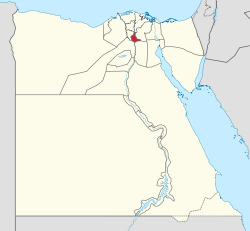Qalyubiyya Governorate
Al-Qalyubiyya Governorate | |
|---|---|
 Qalyubia Governorate on the map of Egypt | |
| Coordinates: 30°25′N 31°13′E / 30.41°N 31.21°E | |
| Country | |
| Seat | Benha (capital) |
| Government | |
| • Governor | Alaa Abdul-Halim Mohammed Marzouk[2] |
| Area | |
| • Total | 1,001 km2 (386 sq mi) |
| Population (January 2018) | |
| • Total | 5,703,000[1] |
| Time zone | UTC+2 (EET) |
| HDI (2017) | 0.698[4] medium |
| Website | www |
Al-Qalyubiyya Governorate (Arabic: محافظة القليوبية Muḥāfazat Al-Qalyūbeya Arabic pronunciation: [alqæljoˈbejjæ]) is one of the governorates of Egypt. Located in Lower Egypt. It is situated north of Cairo in the Nile Delta region. Its capital is Benha.
Benha and several other settlements blend into the neighboring Cairo Governorate; as a result, parts of Qalyubia (particularly Shubra El Kheima) are generally considered to form part of the Greater Cairo metropolitan area (along with Cairo governorate, Giza city and 6 October city).
| Year | Pop. | ±% |
|---|---|---|
| 1937 | 610,157 | — |
| 1947 | 693,908 | +13.7% |
| 1957 | 758,000 | +9.2% |
| 1966 | 1,212,000 | +59.9% |
| 1976 | 1,674,006 | +38.1% |
| 1986 | 2,514,244 | +50.2% |
| 1996 | 3,302,860 | +31.4% |
| 2006 | 4,237,003 | +28.3% |
| 2015 | 5,105,972 | +20.5% |
| 1937–2006, 2015 is an estimate[5] | ||
Municipal divisions
The governorate is divided into the following municipal divisions for administrative purposes, with a total estimated population as of July 2017 of 5,647,716. In some instances there is a markaz and a kism with the same name.[6][7]
| Anglicized name | Native name | Arabic transliteration | Population (July 2017 Est.) |
Type |
|---|---|---|---|---|
| Khanka | قسم الخانكه | Al-Khānkah | 76,744 | Kism (fully urban) |
| Khanka | مركز الخانكة | Al-Khānkah | 574,569 | Markaz |
| Khusus | قسم الخصوص | Al-Khuṣūṣ | 459,586 | Kism (fully urban) |
| El Qanater El Khayreya | مركز القناطر الخيرية | Al-Qanāṭir al-Khayriyah | 507,179 | Markaz |
| El Ubour | قسم العبور | Al-'Ubūr | 130,654 | Kism (fully urban) |
| Banha | مركز بنها | Banhā | 482,959 | Markaz |
| Banha 1 | قسم اول بنها | Banhā 1 | 106,815 | Kism (fully urban) |
| Banha 2 | قسم ثان بنها | Banhā 2 | 64,493 | Kism (fully urban) |
| Kafr Shukr[8] | مركز كفر شكر | Kafr Shukr | 188,858 | Markaz |
| Qaha | قسم قها | Qahā | 47,898 | Kism (urban and rural parts) |
| Qalyub | قسم قليوب | Qalyūb | 146,987 | Kism (fully urban) |
| Qalyub | مركز قليوب | Qalyūb | 561,254 | Markaz |
| Shubra El Kheima 1 | قسم أول شبرا الخيمة | Shubrā al-Khaymah 1 | 483,762 | Kism (fully urban) |
| Shubra El Kheima 2 | قسم ثان شبرا الخيمة | Shubrā al-Khaymah 2 | 682,152 | Kism (fully urban) |
| Shibin El Qanater | مركز شبين القناطر | Sibīn al-Qanāṭir | 540,112 | Markaz |
| Tukh | مركز طوخ | Ṭūkh | 593,694 | Markaz |
Population
According to population estimates, in 2015 the majority of residents in the governorate lived in rural areas, with an urbanization rate of only 44.7%. Out of an estimated 5,105,972 people residing in the governorate, 2,825,045 people lived in rural areas as opposed to only 2,280,927 in urban areas.[9]
Cities
The cities in the Qalyubia Governorate are:
- Benha
- Khanka
- Qaha
- Qalyub
- Shibin El Qanater
- Shubra El Kheima
- Tukh
- El Qanater El Khayreya
- Kafr Shukr
- Obour City
- Khusus
Industrial zones
According to the Egyptian Governing Authority for Investment and Free Zones (GAFI), in affiliation with the Ministry of Investment (MOI), the following industrial zones are located in this governorate:[10]
- Al Shorouk
- Al Safa
- Al Aqrasha
- (New urban community) Al Obour industrial zone
Economy
Qalyubia is known for its agricultural production of crops, fruits and vegetables. The most important of these crops include maize, cotton, wheat, citrus fruits, bananas, oranges and apricots. Qalyubia is also the leading Egyptian governorate in the production of poultry and eggs.[3]
Programs and projects
In 1981, the Basic Village Service Program (BVS) had several water projects going on in the Qalyubia Governorate.[11]
In a program that began on August 28, 2012 (through 2018), the European Union invested 40 million Euros on upgrading the infrastructure of informal areas in Qalyubia Governorate.[12]
References
- ^ "Population Estimates By Governorate ( Urban /Rural ) 1/1/2018". www.capmas.gov.eg. Archived from the original on 2018-11-02. Retrieved 10 October 2018.
- ^ "رسمياً.. المحافظون الجدد ونوابهم يؤدون اليمين الدستورية أمام الرئيس". Almasry Alyoum (in Arabic). 30 August 2018. Archived from the original on 2018-08-31. Retrieved 2018-08-31.
- ^ a b "Al-Qalyūbiyyah GOVERNORATE, EGYPT". britannica.
- ^ "Sub-national HDI - Area Database - Global Data Lab". hdi.globaldatalab.org. Retrieved 2018-09-13.
- ^ "Population History (Al Qalyūbīyah)Population, 1966–2006". Statoids. Archived from the original on 2016-10-14. Retrieved October 16, 2016.
- ^ "Qalyubia Governorate Subdivisions". CityPopulation.de. Archived from the original on 2018-11-25. Retrieved 2018-11-24.
- ^ "Markazes of Egypt". statoids.com. Gwillim Law. Archived from the original on 2017-10-19. Retrieved 26 November 2018.
- ^ "Markaz Kafr Shukr". Google Map.
- ^ "Population Estimates By Sex & Governorate 1/1/2015" (PDF). CAPMAS. Archived (PDF) from the original on 2015-10-19. Retrieved 23 October 2016.
- ^ "Industrial Zones of Governorate". Ministry of Investment Egypt. Archived from the original on 2018-11-23. Retrieved 23 November 2018.
- ^ "Egypt: The Basic Village Services Program" (PDF). USAID. Archived (PDF) from the original on 2016-10-19. Retrieved 19 October 2016.
- ^ "Upgrading Informal Areas in the Greater Cairo Region". European Union External Action. Archived from the original on 2017-01-02. Retrieved 2017-01-02.


